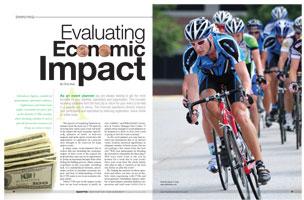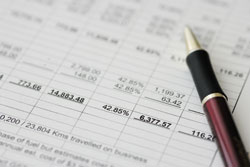
As an event planner you are always looking to get the most benefits for your athletes, spectators and organization. This includes receiving subsidies from the host city in return for your event to be held in a specific city or venue. This financial assistance directly impacts your participants and spectators by reducing registration, venue rental or ticket costs. The process of acquiring financial assistance from the host city CVB starts by showing how much your event will positively impact the local economy. Specifically, planners of small- to mid-size amateur and niche sports events have the opportunity to capitalize on a process once thought to be reserved for large sports events.
 In many cases, event planners fail to realize that not including the economic impact of their event in the request for proposal they miss out on an opportunity to create an increased demand from cities during the bidding process. Many reasons contribute to this oversight, including lack of a standardized formula, uncertainty on how to calculate economic impact, and lack of understanding of what the CVB wants to see in an economic impact report.
In many cases, event planners fail to realize that not including the economic impact of their event in the request for proposal they miss out on an opportunity to create an increased demand from cities during the bidding process. Many reasons contribute to this oversight, including lack of a standardized formula, uncertainty on how to calculate economic impact, and lack of understanding of what the CVB wants to see in an economic impact report.
"Most CVBs rely on the impact events have on our local economy to justify its own viability," said Bakersfield Convention & Visitors Manager Don Cohen. "I cannot stress enough to event planners to be prepared to show us how your event is going to fuel the local economy."
As the event planner you may lean toward one destination due to its perfect venue, location, historical significance or adequate number of hotel rooms, but are you getting a fair return from the host city? Will your participants be flooding the downtown restaurants for three days? Will every hotel room in the city be booked for a week due to your event? Does your event draw the whole family who plan to take a vacation in the host city before or after the event?
By finding the answers to those questions and others you have an ace-in-the-hole when negotiating with CVBs and local sponsors. Attendance figures, number of participants, potential audience impressions and total room nights consumed are just a few of the statistics CVBs consider when deciding whether or not to provide financial assistance to bring an event to town. The key is to present accurate and valid data that can be sourced.
By knowing what CVBs want and how to obtain the information, you will get the most return for your organization when choosing a host city. The economic impact events carry is the backbone of most CVBs' existence. By understanding the importance of calculating and evaluating economic impact, event planners can undoubtedly create a demand for their event within a community. If as a planner you have not made it standard to include an economic impact analysis of your event in your RFP, you may have missed a prime opportunity to receive benefits for your organization or participants – just by showing up!
What's the Magic Formula?
One of the problems stems from event planners and CVBs using many different formulas to determine economic impact. Some formulas are drawn from primary research, some from secondary sources. Others include spending categories unique to an event. Some entities choose to use a multiplier, an estimate of money spent by attendees of an event that is circulated throughout a region after the event leaves town.
As you can see, the variables as to what should be included in an economic impact formula make determining the economic impact of your event complex. In addition, every city, region and state has varying hotel rates, venue fees and transportation costs. Those factors play a role in determining the true economic impact of the event for a particular destination. Even by utilizing the most thorough methods of data collection, predicting economic impact is a difficult task.
"It's an ongoing issue with calculating economic impact," said Matt Billingsley, sales manager at the Bakersfield Convention & Visitors Bureau. "Using a specific formula in one city may not be applicable for the same event in a different city and event planners who recognize and address this can really use it to their advantage when talking to CVBs."
 |
| Photo by Dennis G. Esler - www.eslerphoto.com |
Recently city officials in a California metropolitan area paid nearly $65,000 for a firm to develop a standard formula for local organizations to determine the economic impact of sports events on the city. The problem stemmed from the city's economic development department, the sports commission and the CVB each having its own formula for determining the economic impact of sports events. Each entity reported varying economic impact numbers to the public. In one case two entities reported figures differing by over $25 million for the same event. This one example underscores the importance of determining economic impact and more so the struggle for entities to accurately estimate the value of the event to the area.
At a minimum it is advised you include in your RFP the basic components of event economic impact. Total out-of-town attendance (local attendance figures should be a separate section), total room nights, projected meal spending and travel expenses will give you the ability to place a realistic value on your event.
Determining what components you will include in calculating economic impact is only half the battle. Estimating what numbers to use for each component is essential in putting together a sound economic impact analysis.
Calculating
If you are lucky, your organization has been measuring economic impact for your event for decades. For many larger events this is common practice, but smaller event planners may not have the time or resources to conduct in-depth research. No matter the size of event, there are a wide range of methods to measure economic impact that fit within budget, personnel and time constraints.
Employing your own volunteers, employees or a third-party research firm to conduct surveys at your event to determine attendee spending is considered one of the most accurate determinations of economic impact. A sample of participants or attendees is asked to fill out a survey about estimated spending over the duration of the event. This data is then analyzed and spending by industry and overall spending can be estimated. For a large event with significant attendance numbers there may be justification for event planners, CVBs and sports commissions to collaboratively invest in this type of research.
"CVBs understand amateur sports organizations and volunteer-based athletic associations may not have the resources to conduct on-site research," said Cohen. "However event planners can still use other methods to estimate the potential economic impact of their event."
Alternative techniques to calculate economic impact can be achieved through cost-effective and simple methods. Commonly your event requires a hard copy or online registration form for participants to sign up. Simply add a few questions that are most important to help you calculate economic impact. How many nights do you plan to stay in a hotel? How many people will you be traveling with? About how many meals do you plan on eating at a restaurant? How much did you budget to spend over the length of your stay? Do you plan on staying in the host city before or after the event? If so, how many nights?
To ensure a higher participation rate you can offer a certain dollar amount off of registration fees to survey participants as an incentive.
Still too much work for your staff? No problem. Many state sports commissions and tourism agencies already have statewide average travel spending calculators or formulas available to the public. These formulas generally take a wide swath of data from many locations to determine an average amount of spending per person or average group size.
 For example, in California, the California Travel and Tourism Commission employs a third-party research firm to determine statewide average spending for individuals and groups. These formulas include traveler spending data from cities across the state, resulting in a standard formula event planners can use and source when presenting the economic impact of an event to CVBs.
For example, in California, the California Travel and Tourism Commission employs a third-party research firm to determine statewide average spending for individuals and groups. These formulas include traveler spending data from cities across the state, resulting in a standard formula event planners can use and source when presenting the economic impact of an event to CVBs.
Although considered less precise than the previous two methods discussed, event planners can use these formulas to create a consistent measurement of economic impact. By using the same methods of measurement over multiple years of your event you can create a baseline, which will give you the data you need to work more effectively with CVBs.
What Do CVBs Want?
It should be clear by now: CVBs want to know what impact your event will have on a host city's economy. With dwindling budgets, staff reductions and shrinking hotel occupancy rates, it is more important than ever for CVBs to accurately determine and report economic impact of events to its stakeholders. More importantly, it is vital event planners make the economic impact figures a customary element of RFPs.
"When I sit down with an event planner, I want to see a solid attempt has been made to show how their event is going to positively impact my community," said Billingsley. "I have difficultly moving forward with a planner who insists on receiving substantial financial support from the CVB without making an attempt to analyze potential economic impact for their event."
Transparency is key during initial talks with CVBs. Overestimating, exaggerating or speculating about the economic impact of your event can have a negative impact on negotiations. It is understood no one economic impact formula is perfect, however by presenting consistent data and thorough collection methods you stand to gain the trust of CVBs.
Part of the transparency comes from relaying unique information about the event and its attendees. Event planners must know the tendencies of their attendees and any special characteristics that may change the economic impact.
In many cases CVBs prefer the event planner provide detailed raw statistics or a historical snapshot of the event. This information is plugged into a formula used by the CVB to determine economic impact. This is a common practice among CVBs,allowing them to collect consistent data for monthly, quarterly and annual reports.
"For most prospective events CVBs will run their own economic impact analysis," said Billingsley. "However we cannot do that without the assistance and knowledge of the event planner."
The Bottom Line
The return on investment you will see from calculating economic impact is worth the time, resources and personnel you assign to the task. As with any other venture, the more you invest, the more potential return you may have.
No one formula, method or data collection process has risen to the top as an industry standard. With that in mind, be consistent in your data collection methods, work to understand what the CVBs you are working with want to see and make sure you are fully realizing the potential your event has to obtain financial and other ancillary benefits from your host city.

